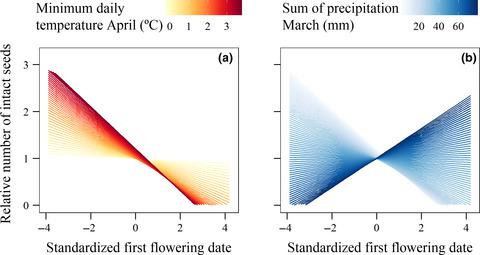当前位置:
X-MOL 学术
›
Ecol. Lett.
›
论文详情
Our official English website, www.x-mol.net, welcomes your
feedback! (Note: you will need to create a separate account there.)
Climate drives among-year variation in natural selection on flowering time.
Ecology Letters ( IF 7.6 ) Pub Date : 2020-01-28 , DOI: 10.1111/ele.13468 Johan Ehrlén 1, 2 , Alicia Valdés 1, 2
Ecology Letters ( IF 7.6 ) Pub Date : 2020-01-28 , DOI: 10.1111/ele.13468 Johan Ehrlén 1, 2 , Alicia Valdés 1, 2
Affiliation

|
To predict long-term responses to climate change, we need to understand how changes in temperature and precipitation elicit both immediate phenotypic responses and changes in natural selection. We used 22 years of data for the perennial herb Lathyrus vernus to examine how climate influences flowering phenology and phenotypic selection on phenology. Plants flowered earlier in springs with higher temperatures and higher precipitation. Early flowering was associated with a higher fitness in nearly all years, but selection for early flowering was significantly stronger in springs with higher temperatures and lower precipitation. Climate influenced selection through trait distributions, mean fitness and trait-fitness relationships, the latter accounting for most of the among-year variation in selection. Our results show that climate both induces phenotypic responses and alters natural selection, and that the change in the optimal phenotype might be either weaker, as for spring temperature, or stronger, as for precipitation, than the optimal response.
中文翻译:

气候会导致开花期自然选择的年际变化。
为了预测对气候变化的长期响应,我们需要了解温度和降水的变化如何引起直接的表型响应和自然选择的变化。我们使用22年的多年生草本植物山thy豆(Lathyrus vernus)的数据来研究气候如何影响开花物候和物候的表型选择。春季开花的植物早期开花,温度更高,降水更高。几乎在所有年份中,早开花与较高的适应性相关,但是在温度较高且降水较少的春季中,早开花的选择明显更强。气候通过性状分布,平均适应性和性状-适应性关系影响了选择,后者是选择中年际变化的大部分。
更新日期:2020-01-29
中文翻译:

气候会导致开花期自然选择的年际变化。
为了预测对气候变化的长期响应,我们需要了解温度和降水的变化如何引起直接的表型响应和自然选择的变化。我们使用22年的多年生草本植物山thy豆(Lathyrus vernus)的数据来研究气候如何影响开花物候和物候的表型选择。春季开花的植物早期开花,温度更高,降水更高。几乎在所有年份中,早开花与较高的适应性相关,但是在温度较高且降水较少的春季中,早开花的选择明显更强。气候通过性状分布,平均适应性和性状-适应性关系影响了选择,后者是选择中年际变化的大部分。











































 京公网安备 11010802027423号
京公网安备 11010802027423号